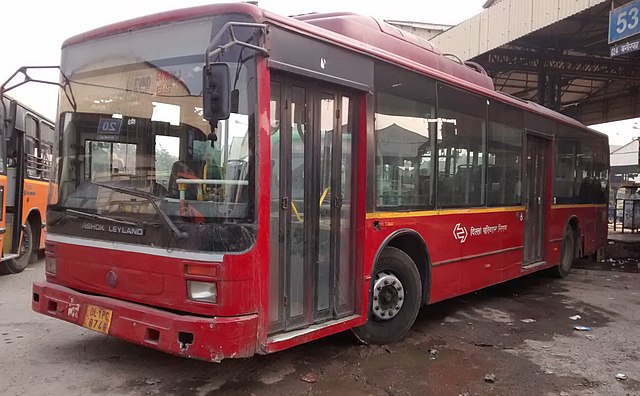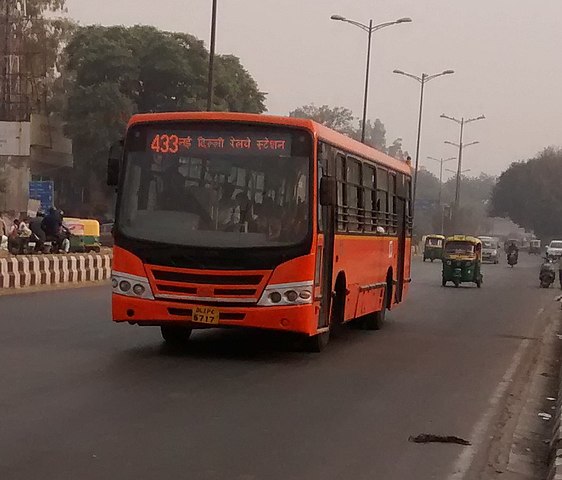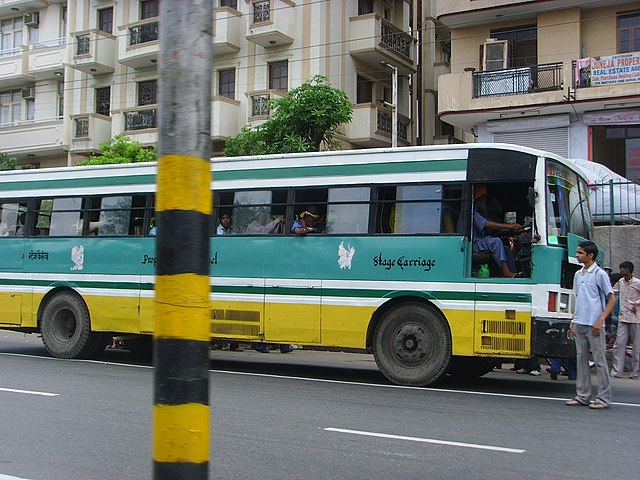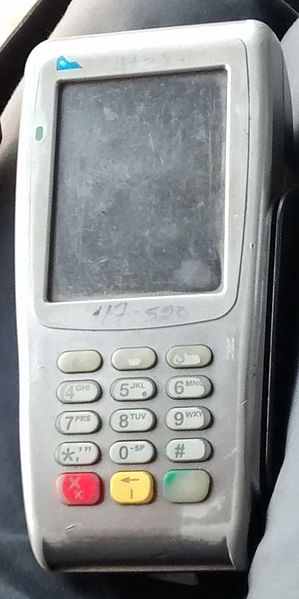Delhi -The National Capital Territory of India, has a serious problem with buses.
Before getting into details, let us just list out modes of transport within the city.
- Delhi Suburban Railway: EMUs and MEMUs connecting Delhi to nearby cities such as Ghaziabad, Faridabad and Gurgaon.
- Delhi Ring Railway: A 35km long railway running parallel to Ring Road, with 7 services clockwise and 7 anticlockwise with a peak hour frequency of 60-90 minutes.
- Delhi Metro: A 213km long Rapid Transit system consisting of a mix of Underground, Elevated and At Grade tracks and stations.
- Buses: Buses, like every other city in India.
- Auto rickshaws: Autorickshaws with GPS-enabled Meters who rarely charge by the fare meter.
Now, coming to Buses.
Delhi has three kinds of buses that operate on its street, all by different operators. Yes. Three of them.
- DTC Buses
- Cluster Buses
- Metro Feeder Buses
DTC Buses

The DTC operates two distinct services in the city. Green coloured non-AC buses and Maroon coloured AC buses. Barring a few old buses which are pre-2000 buses, all the buses are low-floor, rear-engined CNG buses. Buses are either Ashok Leyland or Tata Marcopolo models, in both variants. Daily Passes for both regular and AC services are sold on board the bus like most other cities. Monthly passes are available at 30+ odd centres across the NCT. Barring the Jheel centre, all are computerised. Passes are supremely cheap, with the non AC pass costing ₹800 and AC pass costing ₹1000 a month. Minimum fares are ₹5 for the Green bus and ₹10 for the Maroon counterparts. Similar to what Western and Central Railways did in the Mumbai Suburban Railway and what PMPML did in Pune, fare stages are in increments of ₹5. The highest fare in a non AC bus is ₹15!
Feeder Buses

Operated by the Delhi Metro Rail Corporation [DMRC], these are minibuses with the aim of linking Metro stations to localities around them. The funny part is that similar to Bangalore’s Metro Feeder buses, they travel long distances too. For example, at Saket Station, you can see Feeder buses going upto Badarpur. They follow the same fare structure of the regular DTC bus.
Cluster Buses

And now, for the long part of this article. Cluster Buses. The orange-coloured buses in Delhi, were introduced in 2011 to compensate for the shortage of buses since the Blueline fleet had been eliminated. Delhi’s buses have always had a huge percentage of private players in it, and with the cluster buses, they have been corporatised with under the Banner of Delhi Transit, run by the Delhi Integrated Multi-Modal Transit System Ltd. [DIMTS]. These buses use the same fare stages as the regular DTC buses, except that Daily Passes are not valid on them, and tickets are issued digitally.
Now how does the Cluster Service pan out?
Delhi has always had a mix of private and public buses on its streets.

Till 2010-2011, the private sector was composed of Licenced Stage Carriers, known as Blue Line buses. They were individual buses, operating under no fixed rules, and thus could take any route they wished to. This caused a major issue, since most operators chose only the profitable routes and in order to maximise profits, overloaded the buses as well as drove negligently to make more trips. This often put passengers at risk, and on an average, 100 people died in a year, both inside and outside the bus. In 2008-2010, the then Sheila Dikshit-led government decided to discontinue these buses in favour of the new Corporatisation scheme. Accordingly, permits to operate these buses were withdrawn and new permits were no longer issued. In 2011, the first set of Cluster Buses were launched.
So, what formed the basis for these Cluster Buses and why are they called so?
The DIMTS, a joint venture of the Government of NCT Delhi [GNCTD] and the IDFC Foundation, did a analysis of the 650-odd bus routes in Delhi and grouped them into 17 clusters. A list of the clusters as well their constituent bus routes is available on the GNCTD website. Within these clusters, 40% of the buses were to be run by DTC and the remaining 60% by DIMTS. DIMTS, meanwhile is just a Government Body, which among other things, maintains GPS data of every auto-rickshaw in the NCT, which is fitted with a GPS-enabled Fare Meter. The buses themselves are operated by Private Parties. Unlike the erstwhile Blue Lines, they are operated by large corporate bodies. Cluster buses today form the 60% Private share in the 17 clusters, though Private Stage Carriers with the Blue Line livery are slowly making a come back under the current government.
Each Cluster Bus is GPS-enabled with the position being relayed to the Public Information Website [http://businfo.dimts.in/businfo/] which shows the ETA of the buses, similar to what BEST does. Touch-screen Verifone Ticket Machines are utilised on these buses. Since there are only 3 fare stages, the driver only has to press the fare, ₹5, ₹10 or ₹15, and the location is automatically picked up via GPS. Similar to BEST, data is automatically sent to the server, thus eliminating a lot of issues.

So what exactly is the issue here?
Now, there are several issues here, with all the buses in question:
- Fares: Fares in Delhi are too low. With a minimum fare of ₹10 on AC services and fare stages of ₹5, ₹10 and ₹15 only in non AC services, fares are too cheap for both DTC and private operators to sustain themselves, even with low taxes and cheap CNG. It costs ₹15 in a bus from Okhla to Old Delhi Railway Station. The same journey costs ₹19 in a Metro from Okhla to Chandni Chowk. The only city where a bus ride is cheaper than a train.
- ETMs: The Orange Faeries have GPS-based ETMs that instantly transmit data but have no purpose other than these two. BEST ETMs can sell passes and validate them. There should be a plan to sell Daily Passes with these machines and validate prepaid cards.
- Passes: Daily Passes, even of AC buses are not valid on DIMTS buses, which form 3/5 of the buses on the road. They are also not valid on Feeder buses.
- Feeder buses: Since the feeder buses are out on a contract basis with private carriers, they end up acting like Blueline minibuses.
- Delhi BRTS: The Delhi BRTS is another case of Bus Lanes masquerading as as BRTS. It is similar to the original Swargate-Katraj BRT line in Pune. All sorts of vehicles enter bus lanes, there are no barricades at some place, bus stops are confusing. The funny part of the BRTS is that there are two layers of bus stops, parallel to each other at a junction, resulting in a mini pile-up.
Overall, Delhi’s transport system leaves a lot of space for improvement. DTC also operates buses to neighbouring cities in the NCR, such as NOIDA and Gurgaon. Passes are not valid on these buses. DIMTS doesn’t cross the border. All buses going away from Delhi terminate at the border. DTC also operates a shuttle bus service between Terminal 3 and 1 at the Indira Gandhi International Airport, as well buses to Lahore, Pakistan and Kathmandu, Nepal.
Delhi’s bus problem is that buses try to be direct competition to the Metro. Operations need to be streamlined into a single integrated system, along with some fare hikes to make it sustainable.
![]()

Delhi’s buses are wierd. They get weirder day by day.
Suppose that’s the problem with India.
huh? another
retarded whitemaking some vague comments.lol serves Delhi right for electing for paap
It would be wise if you stopped insulting people in the comments.
Blue lines buses are coming back it seems. Great. Way to go AAP! #Facepalm
There is a lot of improvement which can be done in integrating buses with metro to become a true multi-modal city. DIMTS can also provide ETA to third party apps like Google Maps, which can help increase ridership. Even though the govt. promised to share data during the Odd-Even Plan, they never executed it.